During the last 10 years, industries across all sectors have actively participated in a significant shift towards automation, with solutions for every aspect of production, from automated warehouse management lines to robotic bending cells.
Robot integration revolutionized the sheet metal bending process on press brakes.
Automated press brakes represent for sure an advanced solution for industrial automation, increasing the quality and efficiency of work. Thanks to the advantages of state-of-the-art programming, press brake bending cell can work continuously, providing constant, repeatable and high-quality results, without the variability associated to human operators.
.webp?width=600&height=400&name=SUPERIOR%20MATRIX%20-%20dettaglio%20braccio%20robotizzato%20(1).webp)
How does a bending cell work?
A robotic bending cell is an integrated system that combines a robot and a press brake. This solution allows to automate the entire bending cycle. In particular, automation includes:
- Part picking by the robot, which is equipped with suction cups or magnets
- Thickness control and centering plate
- Bending phase (includes performming of re-grips or turnovers)
- Palletizing
Faster production cycles thanks to robotic bending
The lack of qualified staff has developed an increased need of automated production.
Without any doubt, the scarcity of qualified labor can be considered one of the main factors that has required this change in the workshop organization.
Robotic bending cells are designed to perform a variety of operations. The use of automated solutions allow companies to make the production cycle more efficient, while keeping production costs low, without compromising quality. The robotic bending cell automates the entire bending cycle, from part picking to final palletization, ensuring high-quality and consistent results.
Let's take a real example: the bending department of a company can organize the work on a continuous cycle. You might optimise effectively the work by using the robotic cell during the night to perform all the simplest and repetitive processes, while operators can focus exclusively on the most complex and challenging phases of processing, especially those in which a robot cannot compete with the creativity and added value of an experienced bender.
The operator, released from doing repetitive tasks, can put its attention on other activities, such as preparing for the next processing phases, or can be trained on machine maintenance.
With this kind of organization the company can fully exploit the potential of automation for the simplest working phases, where the human contribution is less appreciated.
On the other hand, companies can employ human capital on more remunerative tasks, fostering the development of new skills and creating the conditions to retain the most valuable resources.
MATRIX: robotized cells without limits
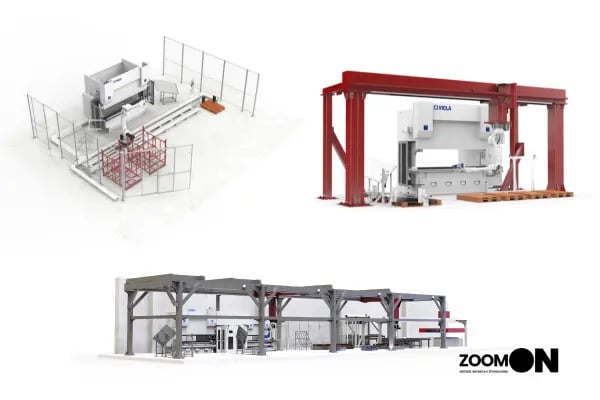
To meet these needs, VICLA has designed MATRIX, the fully customizable robotic cell that perfectly meets the real needs of customers.
It is a highly performing integrated system, easy to program and designed to meet the needs of the individual customer.
VICLA stands out for the high level of customization of both the robot and the press brake, which can be configured in terms of power and length, while the integration with the robot is designed according to the customer's needs.
The cell configuration is highly versatile and allows to easily switch from automatic to standalone mode when needed.
The design is compact and can be configured according to the space available. The robot can pick a wide variety of sizes, even the smallest, thanks to different gripper options.
It is possible to equip the robotic cell with a mobile or press brake-integrated (ATC) tool changer and obtain a fully automated bending system.
The high-tech sensors ensure a consistently accurate bending angle. The angle control, the adaptive crowning system, and the Flex device ensure perfect linearity even on non-uniform materials.
Matrix offers a suite that combines bending software and robot programming in a single environment, also allowing to import drawings, collect real-time data, monitoring production.
These features make the Matrix bending cell particularly reliable and productive, thus helping to meet the shortage of skilled labor.
Due to the fact that it is fully customizable, VICLA offers various custom-designed configurations. The customer can therefore choose a solution with a gantry robot, a rail robot or a fixed platform robot.
Let's see together the advantages of each type.
Robotized cell .Matrix Baseline
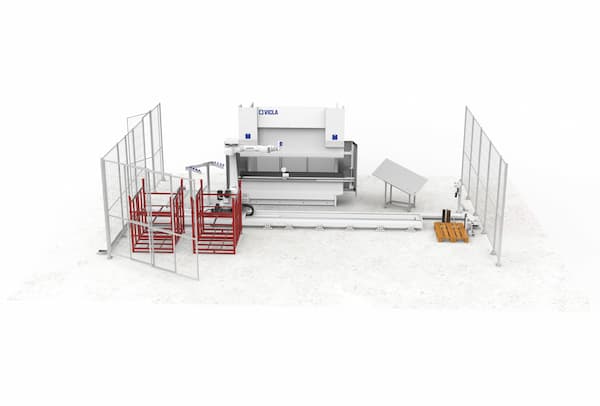
Integrated robotic cell that combines a press brake and a floor-mounted robot. The robot can be configured to move on a rail, thus obtaining a seventh axis, or it can be positioned on a fixed support platform. A bending cell with a rail robot offers a lot of advantages; let's see some of them:
-
Increased flexibility: if the robot is equipped with a seventh axis on a rail, it can serve multiple workstations, allowing for different operations without the need for operator supervision on the machine and the execution of tasks at different points in the production line.
-
Downtime reduction: thanks to the ability to move along the rails, robots can reduce downtime associated with the movement of materials or components within the work area, improving overall production efficiency.
-
Increased productivity: robots moving on rails can avoid the downtime typical of production, optimizing cycle times during the day and the night by serving production lines 24/7, saving time increasing productivity.
-
Better use of space: thanks to their mobility, rail robots can be used more efficiently because they work in a larger space, allowing for better organization of the production area and a strong reduction in the footprint of the machines.
-
First piece right: each process is first designed remotely and feasibility is checked using specific software. The robot checks and positions the part exactly where it needs to be bent, and specific devices are used to verify the position and material, which ensures the right first piece from the beginning.
Matrix Skyline: for a more efficient use of space
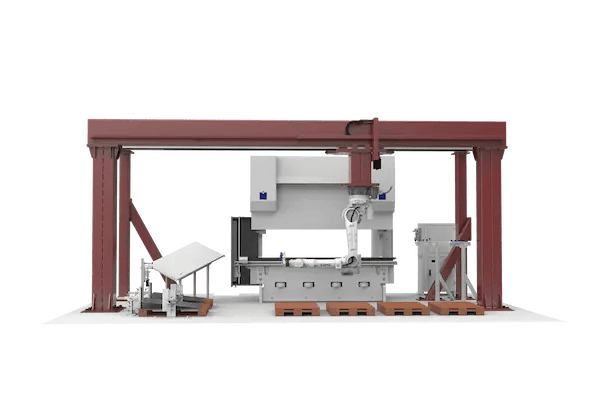
Integrated robotic solution that combines a press brake and a robot mounted on a gantry. This configuration is the best solution when it would not be possible to install a rail-mounted robot due to space limitations.
Thanks to the use of an overhead gantry for the robot, the working area is free of obstacles, allowing for greater flexibility and versatility.
Unlike the version with a floor-mounted robot, this system does not require to place the bending brake on lifting blocks, making it a more versatile solution even when used in standalone mode.
Robotized bending with automatic tool changer
Robotic bending can be integrated with an automatic tool changer that automatically performs even the most complex setups, handles dies up to 70 mm V width, round tools and also allows 180° rotation of the tool.
VICLA ATC - Single or Twin - can reduce setup times by 4 or 5 times compared to manual operations. This system, combined with a bending robot, is the most suitable solution for saving time in the bending cycle, combined with flexibility and production speed.
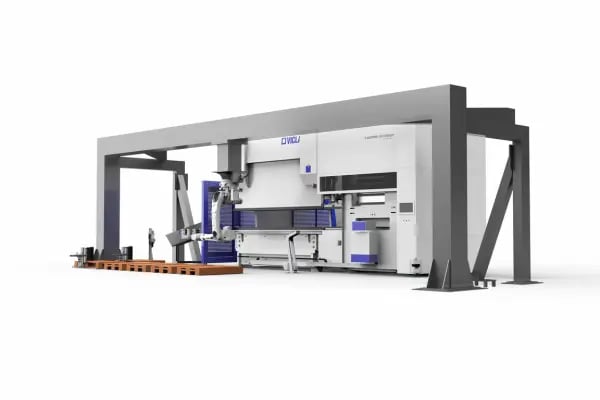
Robotised solutions from laser to bending
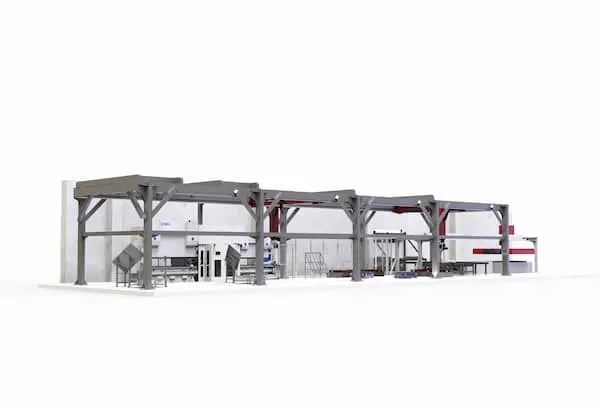 Matrix Tailor is an innovative system that enables the complete automation of laser cutting and metal bending. Its uniqueness lies in the use of two or more 8-axis gantry robots, where the eighth axis is dedicated to bending.
Matrix Tailor is an innovative system that enables the complete automation of laser cutting and metal bending. Its uniqueness lies in the use of two or more 8-axis gantry robots, where the eighth axis is dedicated to bending.
This solution allows the robots to be used not only for bending, but also for sorting and palletizing the laser cut parts.
The automation covers several aspects, including: automatic sorting, part transportation from laser machine to bending machine using by AGV (Automated guided vehicles) robots and bending phase.
The flexibility and versatility of this solution become even more evident when considering that the system can be designed for 24/7 production. During the day, production can be managed by operators and/or robots, while at night the system can operate automatically.
In this way, robots can work with or without human intervention, even carrying out entire shifts fully automatically.
